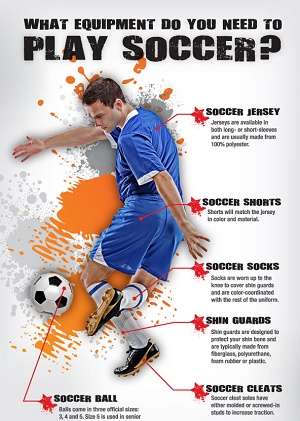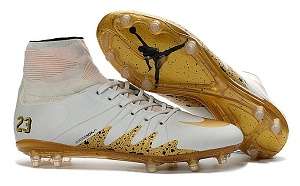What Equipment is Needed to Play Football?
Playing in official league games has some equipment requirements. Players must wear a numbered jersey, a pair of shorts, and some footwear.
You will see all footballers wearing long socks (not ankle length). The long football socks help to cover and trap the shin guards to the lower leg.
Playing association football generally requires less gear than most other ball sports. Even so, wearing the correct footwear would be a soccer essential.
Players like to keep their soccer gear and accessories lightweight. This offers them comfort, and a wide range of movement, throughout the 90 minutes of game time.
So, who governs the football gear list?
FIFA is the governing body overseeing football rules and regulations. They set out soccer equipment rules over all official league games and internationals.
Starting at the head and working our way downward to the feet, here is a guide to the basic soccer equipment list and accessories.
List of Compulsory Equipment for Soccer
A standard soccer accessories list is small compared to some other team sports. These are the minimum things required by players to wear for a try out in soccer:
- Shirt (with short or long sleeves)
- Shorts
- Shin-guards
- Socks
- Footwear
- Soccer ball
Soccer Headgear
Wearing some kind of headgear in soccer is getting more popular each season, especially for younger players. It has become more commonplace as part of youth football equipment for the Under-21 teams.
Football head wear is very light and worn like a trendy headband. Its padded design helps to cushion the impact when heading the ball. Some research also shows a reduction of serious injury if two heads clash together.
Soccer Jerseys UK
Football shirts are a mandatory part of soccer apparel. They are available in long or short sleeve versions. Shirts are most often made from or 100% polyester. Soccer jerseys made from synthetic fabrics help to keep players dry.
An increasing number of jersey manufacturers make them to fit female footballers too. Women shirts tend to be tighter fitting around the shoulders and a little more snug around the waist.
Soccer Gloves
A goalkeeper is the only player wearing gloves ‘every’ game. There is a huge range of different glove models. As a goalie, it is important to wear a design that supports your wrists and provides mobility to the fingers.
So, what do soccer players wear when the weather is cold?
Some outfield players will wear football gloves in very cold weather. The FIFA Official Rules of Football allow it. But, the gloves (mittens) must be lightweight material.
Football Shorts
The rules on wearing soccer shorts are in short supply. Players have worn wide baggy shorts and others have worn short running shorts.
A general rule of thumb applies to most soccer shorts. They should be light, comfortable, and allow freedom of movement.
Short pants should ‘match’ the jersey, both in colour and in material.
Note: The type of shorts used in basketball rules (falling below the knee) are not recommended to play soccer in.
Football Socks
Soccer socks are most often made from thick, durable synthetic fabric or heavy cotton. Football socks get worn up to the knee covering and trapping the shin guards. That is one important reason why footballers wear socks.
Fact, lower leggings are not the most expensive item in the soccer equipment list or football clothing kit. Even so, they should be colour-coordinated to the rest of the player’s uniform.
Note: Soccer socks often slide down your leg. You can buy stocking ties that fit below the knee. The stocking ties get concealed inside after folding the sock down.
 Soccer Shin Pads
Soccer Shin Pads
Wearing soccer shin-guards is mandatory. For this reason, they are an important item to include in any football equipment list.
Soccer shin guards help to protect players most from injuries caused by errant kicks. Even so, shin pads do not always prevent major bone breaks.
Soccer shin pads are ‘specifically’ designed to protect the vulnerable shin bone. They get made from fiberglass, foam, rubber, polyurethane, or plastic. Some shin-guards also include a section as an added ankle support.
Shin guards are available in different thicknesses and models. The type chosen is often determined by specific football positions and their roles.
For example, a striker would usually go for a smaller lightweight model. Whereas, the goalkeeper, defenders, and midfielders often opt for designs with greater coverage.
Football Footwear: Soccer Cleats
As a rule, all professional soccer players play in cleats or turf shoes. Soccer cleats are special footwear made for playing football.
Soccer cleat soles have molded or screw-in studs to improve traction on a grass pitch. Kicking the ball is quite painless due to the rigid material.
Cleats also provide some foot protection against getting stepped on.
There are many different shapes and sizes of cleats with varying prices. Make sure your football footwear is close fitting and a comfortable fit. You need good foot support for the sudden stops and nifty dribbling moves in soccer.

The length of the studs should be appropriate to the type of the playing surface. You will find longer metal studs better on softer grass. Shorter plastic or rubber studs tend to excel on harder ground.
Note: Children are usually limited to wearing turf shoes. This is for soccer health and safety reasons. Football footwear must be appropriate to the playing surface. Thus, outdoor cleats are not permitted on indoor artificial surfaces. Players often use court trainers instead, when playing indoor football.
Football Goalkeeper Equipment List
Some specialist items of football gear and clothing only apply to goalkeepers. For example, they always wear special goalkeeper gloves. They will be standard items of hand wear in any soccer gear list for a goalkeeper.
Padded gloves help to protect their hands from the impact of the ball. They also help keepers get a firm grasp of the ‘synthetic outer surface’ of the modern football ball.
All goalies must wear a different coloured jersey to the outfield players of each team. The rules do not allow the colour to match those of the referee or the officials either.
Note: Each keeper should wear a different coloured top to their opposite counterpart. But, the referee can allow the game to go ahead even if the two goalkeepers are wearing the same coloured shirts.
In case you were wondering…
- An undershirt must be of the same colour, and matching the main colour, as the shirt sleeve.
- Undershorts (e.g. leggings) must be colour the same as the main colour of the shorts or the lowest part of the shorts. Thus, any players wearing them on the same team must all wear the same colour.
- Only the goalkeepers of the team can wear tracksuit bottoms.
Forbidden Items or Field Equipment in Soccer
The rules do not allow radio technology communication between technical staff and players. Soccer equipment and clothing must not feature any personal statements. The same rules apply to the prohibition of any political or religious slogans.
Players cannot wear jewelry during the match. Thus, they must remove it before the kick off. The ban applies to bracelets, leather bands (or rubber), rings, necklaces, and earrings.
Note: The rules do not allow players to cover jewelry with tape (unlike the rules of netball). But, some exceptions do apply for wedding rings.
The only item of cosmetic jewelry worn by soccer referees is a watch. There are specific football referee rules on player equipment inspection. They relate most to arm casts and protective headgear. Even so, many of the soccer associations ban them altogether.
FIFA regulation now allows most protective eyewear, headgear, and face masks. They also permit wearing some knee and arm protectors. That is providing they get made from soft materials.
Soccer Training Equipment for Coaches
Football coaches often use plastic cones and plastic disks in soccer training equipment. They hand out soccer bibs, called pinnies, when they organize a practice session.
Many coaches speed up practice drills using small portable goals and rebounding nets. Trainers may also use speed parachutes and set up agility ladders. This type of football training gear improves player speed at the higher levels.
Soccer Ball
Modern soccer balls come in three official sizes. FIFA soccer ball specifications apply to all size 3, 4, and 5 balls. Size 5 football balls are used in senior and professional competitions. Whereas, junior football players will use size 3 and 4 soccer balls.
FIFA Football Help Guides
A to Z List of Football Teams Names | An up-to-date listing of clubs, location, and stadium capacity.
Football Goal Celebration Rules | How does FIFA govern the way players celebrate when scoring?
Soccer Penalties Rules | Learn how the new ‘ABBA’ system of sudden death penalty shootout works.

